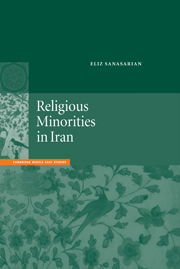Book contents
- Frontmatter
- Contents
- List of illustrations
- List of tables
- Preface
- Acknowledgments
- Notes on transliteration and bibliography
- Glossary
- Introduction: an overview of politics and society
- 1 Ethnic anatomy and politics of non-Muslim minorities
- 2 The Assembly of Experts: debut in the year of destiny
- 3 Policy sphere of recognized religious minorities
- 4 Distinctions and designations as policy output
- 5 Prevalent responses of recognized religious minorities
- Conclusion: the perils of marginality
- Notes
- Bibliography
- Index
- Titles in Series
2 - The Assembly of Experts: debut in the year of destiny
Published online by Cambridge University Press: 22 September 2009
- Frontmatter
- Contents
- List of illustrations
- List of tables
- Preface
- Acknowledgments
- Notes on transliteration and bibliography
- Glossary
- Introduction: an overview of politics and society
- 1 Ethnic anatomy and politics of non-Muslim minorities
- 2 The Assembly of Experts: debut in the year of destiny
- 3 Policy sphere of recognized religious minorities
- 4 Distinctions and designations as policy output
- 5 Prevalent responses of recognized religious minorities
- Conclusion: the perils of marginality
- Notes
- Bibliography
- Index
- Titles in Series
Summary
The constitution of the Islamic Republic of Iran was the first significant document marking the ideological direction of the new state and the status of its religious minorities. The open proceedings put on display a multitude of issues including differing views on the legal status of religious minorities, the powerful role of Ayatollah Beheshti, and the critical impact of the non-Muslim deputies on the final draft of the constitution.
The constitution was written in the summer and autumn of 1979 during an extremely tumultuous revolutionary atmosphere. The year was marked by the executions of former military and civilian officials, clashes between various leftist forces, fighting between the leftist and pro-Khomeini supporters, battles between government troops and various Muslim ethnonational groups in provinces (including fighting between the Kurds and the Azeris), a series of assassinations including the killing of Ayatollah Morteza Motahhari (one of the main ideologues and a member of the Revolutionary Council) and the wounding of Ali-Akbar Hashemi Rafsanjani in Tehran (in May), the closing of some two dozen opposition newspapers (in mid-August), and the takeover of the American Embassy (in November).
The exact details of what transpired before or during the publication of the first draft constitution endorsed by Ayatollah Khomeini and the draft which was adopted and developed by the Assembly of Experts (Majlis-e Khebregan) is unclear.
- Type
- Chapter
- Information
- Religious Minorities in Iran , pp. 58 - 72Publisher: Cambridge University PressPrint publication year: 2000

